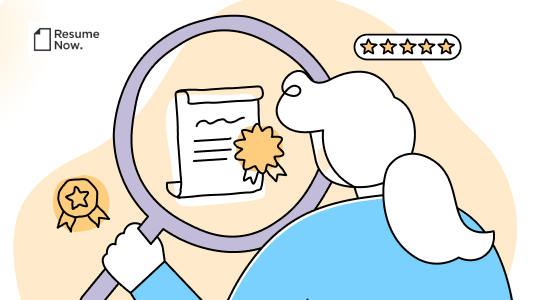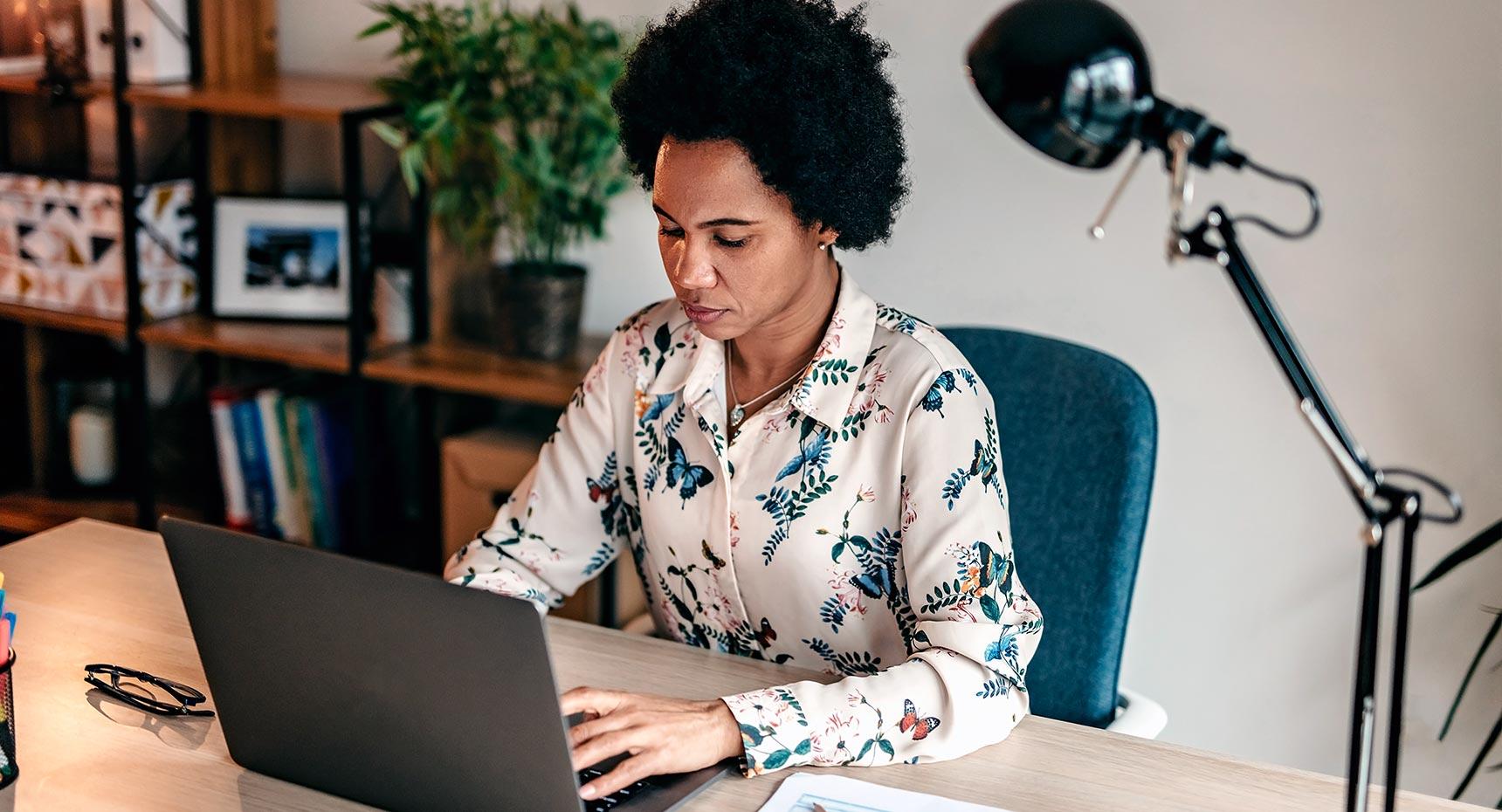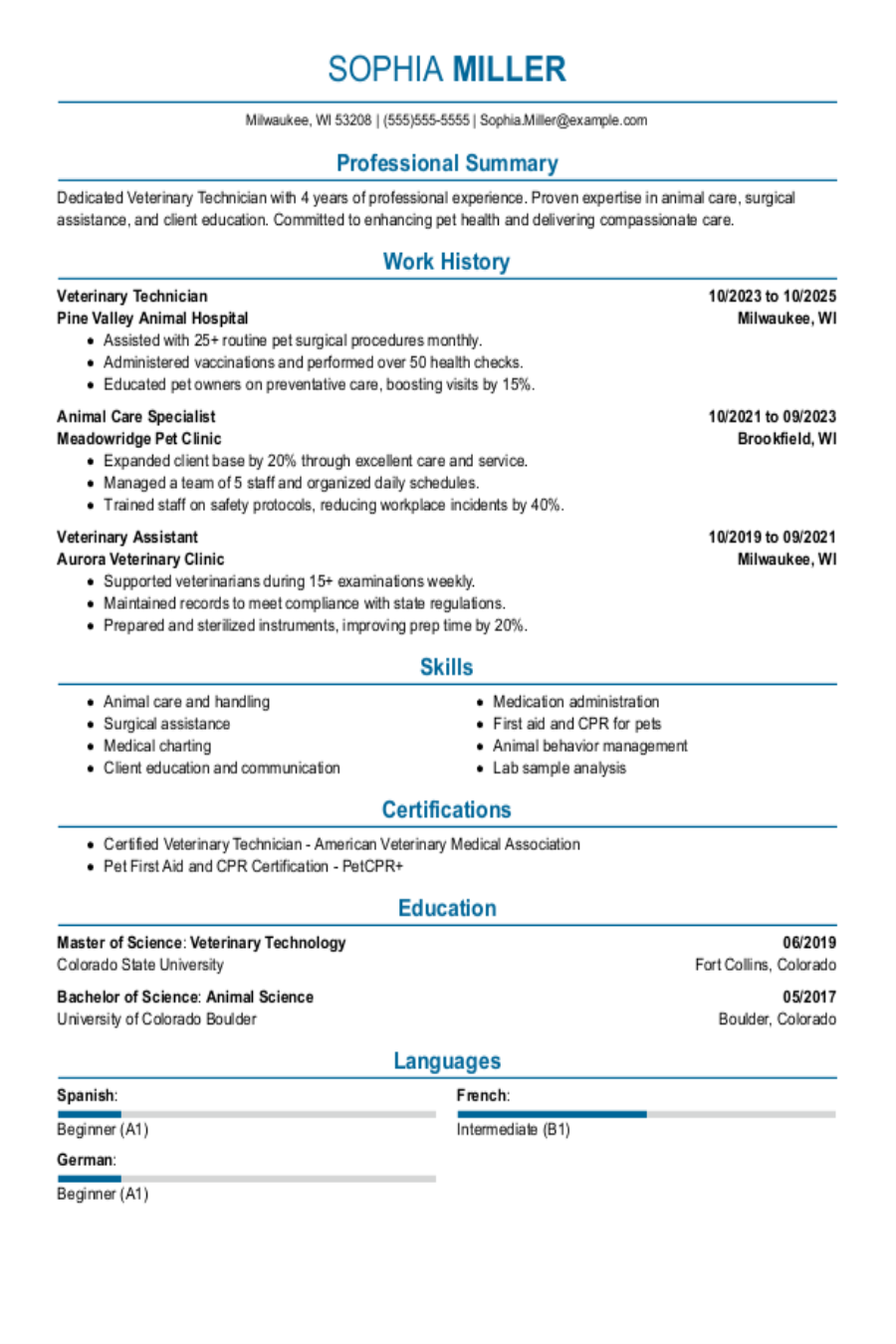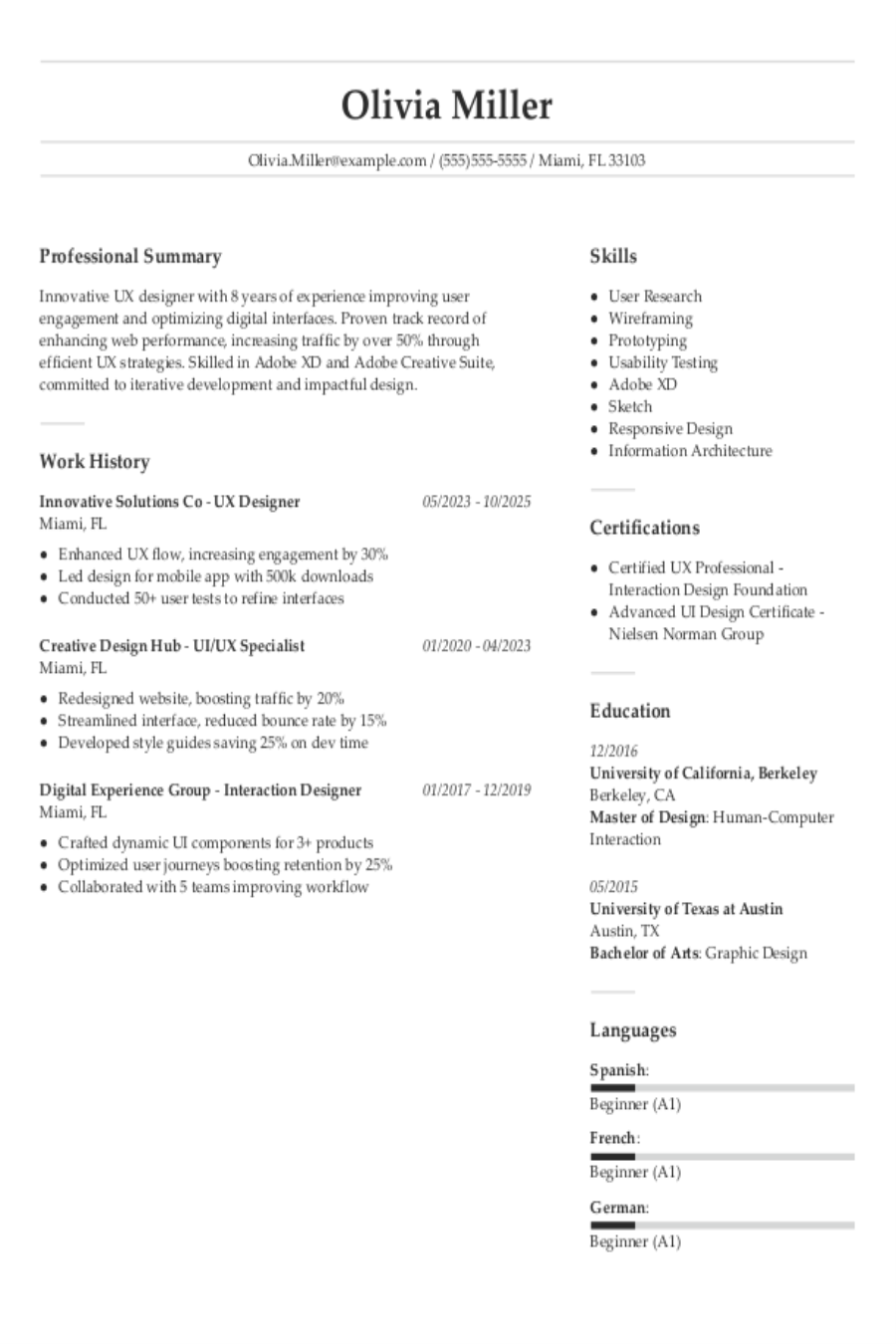Table of contents
Popular Graphic Designer Resume Examples
Entry-level graphic designer resume
An entry-level resume for a graphic designer should focus on showcasing a strong portfolio, relevant coursework, design software skill, and collaborative projects to demonstrate creativity and potential.
Emphasizes soft skills: This resume emphasizes the job seeker's strong soft skills, such as creative problem-solving and the ability to improve brand value, which effectively offset limited experience.
Showcases education: This applicant effectively highlights their education by placing their degrees near the top pf the document.
Mid-career graphic designer resume
A mid-career graphic designer resume should emphasize a strong portfolio, relevant skills, and professional achievements that demonstrate both creativity and growth within the design industry.
Encourages quick scanning: Clear design and structured organization make this resume easy to read at a glance, showcasing expertise in graphic design and significant achievements effectively to potential employers.
Employs active language: Using action verbs such as "managed," "improved," and "led" highlights initiative and effectiveness, showcasing leadership in driving project success and client satisfaction.
Experienced graphic designer resume
An experienced graphic designer resume should emphasize the job seeker's creative projects and skills in a clear format that highlights their professional growth and design impact.
Follows traditional format: The chronological resume format effectively showcases the job seeker's extensive experience by presenting a clear timeline that highlights significant achievements and roles, making it easy for potential employers to follow their career trajectory.
Quantifies achievements: Quantifiable achievements provide clarity in a graphic designer's resume by illustrating the direct impact of their work. By showcasing specific metrics, such as increased engagement rates, recruiters can quickly grasp the job seeker's effectiveness and contributions.
No experience graphic designer resume
A resume for an applicant with no experience should highlight relevant skills, coursework, and creative projects to showcase artistic potential and commitment to design.
Overcomes lack of work history: Emphasizing professional skills highlights the job seeker's design skill and creative problem-solving abilities, showcasing their readiness for a graphic designer role despite limited experience.
Leads with education: Highlighting degrees near the top of their resume and featuring academic achievements in the accomplishments section makes this resume stronger, even without extensive experience.
More resume examples
Graphic Designer Resume Template
Kickstart your career with this graphic designer resume template. Simply personalize it by adding your details and showcasing your unique skills and experiences.
Jin Martinez
Greenfield, IN 46145
(555)555-5555
Jin.Martinez@example.com
Skills
- Adobe Creative Suite
- Typography
- Branding Strategy
- Digital Illustration
- UX/UI Design
- Visual Storytelling
- Motion Graphics
- Color Theory Expertise
Certifications
- Certified Graphic Designer - Graphic Design Association
- Advanced Illustrator Techniques - Adobe Academy
Education
Master of Arts Graphic Design
University of Washington Seattle, WA
June 2016
Bachelor of Fine Arts Visual Arts
California Institute of the Arts Valencia, CA
June 2014
Languages
- Spanish - Beginner (A1)
- French - Intermediate (B1)
- German - Beginner (A1)
Professional Summary
Dynamic graphic designer with expertise in digital media, branding, and visual storytelling. Proven track record of enhancing engagement and reducing design costs, leading innovative projects across industries.
Work History
Graphic Designer
Creative Visions Studio - Greenfield, IN
February 2023 - October 2025
- Designed 50+ digital ad campaigns
- Reduced design costs by 20%
- Led team on 8 branding projects
Visual Content Developer
Digital Arts Workshop - Greenfield, IN
February 2018 - January 2023
- Developed e-learning modules for 5 brands
- Increased engagement by 15% in campaigns
- Oversaw production budgets up to $10K
Multimedia Artist
Creative Media Concepts - Indianapolis, IN
February 2017 - January 2018
- Produced 100+ animations, boosting traffic
- Innovated graphic strategies to save 25%
- Managed digital archives, streamlined workflow
Must-Have Skills on a Graphic Designer Resume
A strong skills section is a key component of an effective resume.
Creative and design professionals transform ideas into visual experiences that engage and captivate. The skills you highlight should show how you bring originality and thoughtful insight to projects. Your resume lets you demonstrate your role in shaping meaningful, memorable work that supports broader goals.
The following data highlights the most prevalent hard and soft skills for graphic designers based on insights from Resume Now’s internal resume data.
When you're ready to improve your resume with relevant skills, check out our AI Resume Skills Generator. It offers tailored suggestions for both hard and soft skills that align with your job title, helping you create a comprehensive and customized skill profile.
Writing Your Graphic Designer Resume
Having explored these impressive resume examples, you're now prepared to dive into the art of writing your own. In the following sections, we will guide you step by step on how to write a resume that stands out and effectively represents your skills.
List your most relevant skills
An strong skills section on your graphic designer resume should focus on both your technical abilities—like skill in design software and understanding of color theory—and essential soft skills such as creativity and effective communication. Highlighting these skills demonstrates your capability to meet the demands of the role.
To improve your chances of catching the eye of recruiters, carefully read through the job listing and incorporate relevant keywords from the job listing into your skills section. This strategy not only appeals to human reviewers by aligning with their expectations but also helps you navigate applicant tracking systems effectively.
Example of skills on a graphic designer resume
- Proficient in Adobe Creative Suite for producing stunning visual content
- Strong understanding of typography and color theory to improve designs
- Creative thinker with a collaborative approach to projects
- Excellent communicator who effectively presents design concepts
A well-crafted skills section demonstrates your readiness for the graphic designer role. Include relevant technical skills listed in the job description, such as skill in design software, and pair them with essential soft skills like creativity and communication. This combination showcases your comprehensive preparation to excel in the position.
Highlight your work history
Your work experience section allows you to showcase your creative achievements and illustrate how you've applied your design skills in various projects. Focus on quantifiable results, like increased engagement or successful campaigns, to make a strong impression on potential employers.
For each job entry, include essential information such as your title, the name of the employer, and the dates you were employed. This clarity helps hiring managers quickly understand your professional background and evaluate your fit for their team. Incorporating industry-specific keywords will also improve the visibility of your resume during applicant tracking system scans.
Example of a graphic designer work experience entry
- Graphic Designer
Creative Solutions Inc. - San Francisco, CA
June 2019 - Present - Develop creative visual concepts and designs for digital and print media, improving brand identity and engagement
- Collaborate with clients to understand their vision, resulting in a 30% increase in client satisfaction based on feedback surveys
- Use Adobe Creative Suite to produce high-quality graphics and layouts, improving project turnaround time by 25%
- Conduct market research to stay current with design trends, leading to innovative solutions that captured audience attention effectively
- Mentor junior designers, fostering skills development and teamwork that contributed to a more cohesive design process
Highlighting outcomes and achievements in your experience section demonstrates your ability to deliver results that matter. Employers are eager to see how you’ve positively impacted projects or teams, as this showcases your creativity and problem-solving skills. By focusing on what you’ve accomplished rather than just listing duties, you create a compelling narrative that sets you apart from other job seekers.
Add portfolio work to your resume
For graphic designers, crafting a resume that highlights your visual skills while prompting employers to explore your portfolio can be challenging. It’s essential to showcase standout projects that exemplify your design prowess without overwhelming the reader.
Place a link to your online portfolio at the top of your resume, ideally near your contact information. Consider adding a portfolio highlights section with 3-4 key projects, using bullet points for easy readability. Ensure each description is concise yet strong, emphasizing specific design techniques or outcomes.
Example of a portfolio highlights section
- Logo Design for Fresh Start Bakery – Developed a modern logo that increased brand recognition by 45%
- Social Media Campaign Graphics for Eco Warriors – Created eye-catching visuals that boosted engagement by 60%
- Product Packaging Redesign for Nature’s Treats – Improved packaging aesthetics leading to a 30% sales increase
- "Cityscape" Illustration Series – Featured in Digital Art Showcase, gaining positive reviews from industry peers
Include your education
The education section of your graphic designer resume should be organized in reverse-chronological order, starting with your most recent degree. Include relevant diplomas and degrees while omitting your high school diploma if you possess a higher qualification.
If you are currently pursuing further education or have incomplete studies, list the highest level completed along with an expected graduation date. It is also useful to include bullet points that showcase relevant courses or significant academic projects. This strategy works best for students and recent graduates, as it emphasizes educational achievements during early career stages.
Common certifications for a graphic designer resume
- Adobe Certified Expert (ACE) – Adobe Systems
- Certified Graphic Designer (CGD) – Association of Registered Graphic Designers (RGD)
- Graphic Design Certification (GDC) – International Association of Business Communicators (IABC)
- Certified Digital Designer (CDD) – Digital Arts and Technology Institute
Sum up your resume with an introduction
Creating a strong profile section on your resume is important for making an effective first impression. This section serves as your introduction, showcasing your skills and experience right at the top, which helps employers quickly understand what you bring to the table.
If you have extensive experience as a paralegal, using a professional summary can be particularly effective. This format allows you to highlight significant accomplishments and specific skills that set you apart from other job seekers, giving hiring managers a snapshot of your qualifications right away.
If your experience is still growing, write a resume objective that underscores your commitment to learning and improvement.
Professional summary example
Creative graphic designer with over 5 years of experience in developing visually compelling content for diverse brands. Demonstrated success in improving brand identity through innovative design solutions, effective use of typography, and mastery of digital illustration. Proficient in Adobe Creative Suite and responsive web design, consistently delivering projects on time while exceeding client expectations.
Resume objective example
Creative graphic designer eager to apply strong design skills, attention to detail, and a keen eye for aesthetics to improve brand visibility for an innovative company. Committed to delivering engaging visual content that resonates with audiences and drives effective marketing strategies.
In your resume profile, you have a prime chance to highlight key skills and qualifications. Carefully analyze the job description for relevant keywords, then weave them into your introduction. This strategy not only improves your visibility but also helps your resume navigate through ATS filters effectively.
Add unique sections to set you apart
Incorporating optional resume sections can significantly improve your profile as a graphic designer. These areas allow you to showcase unique qualifications that set you apart from other applicants.
By including relevant hobbies and volunteer experiences, you provide insight into your skills and personal values. This not only highlights your creativity outside of work but also demonstrates how you engage with the community. Sharing these aspects helps potential employers understand your working style and passion for design, making your application more memorable and strong.
Three sections perfect for a graphic designer resume
- Work Samples: Including a portfolio section in your creative resume is essential for a graphic designer. Showcase 3-5 standout projects that illustrate your design skills, creativity, and problem-solving abilities to leave a lasting impression on potential employers.
- Client Testimonials: Including client testimonials on your resume can set you apart in the creative field. Choose 2-3 strong quotes that showcase your design skills, professionalism, and ability to exceed expectations.
- Awards and Recognition: Including awards on your resume improves your appeal to employers. Highlight any relevant accolades, certifications, or industry honors by detailing the awarding body and the date you received them.
5 Resume Formatting Tips
- Choose a format that matches your career stage.
Choosing an appropriate resume format is important for showcasing your skills effectively. If you have ample experience, a chronological format highlights your career progression well. For those just starting, a functional format emphasizes relevant skills over work history. A combination format can also provide a balanced view for job seekers with varied experiences.
- Pick a smart resume template.
Using a professional resume template is essential for ensuring your information is easily readable. A well-structured template helps highlight key skills and experiences at a glance. If you opt not to use one, prioritize clarity with simple layouts and ATS-friendly fonts for the best results.
- Select an appropriate font.
Using clean, professional font options like Helvetica, Garamond, or Verdana improves your resume's readability and ensures clarity for both ATS and hiring managers.
- Use consistent formatting.
Align your resume to the left with equal margins on all sides. This creates a clean, professional look that is easy for employers to read.
- Keep your resume to one or two pages.
When creating your graphic designer resume, remember that resumes should be one page long. If you have extensive experience, you may extend it to two pages. Focus on being concise and highlighting your most relevant skills and accomplishments.
What’s the Average Graphic Designer Salary?
Graphic designer salaries vary based on location, career level, and qualifications.
This data, provided by the Bureau of Labor Statistics, will show you expected salary ranges for graphic designers in the top 5 highest-paying states, including the District of Columbia. The figures reflect the most current salary data available, collected in 2024.
- Full Range
- Most Common (25th–75th percentile)
- Average
District of Columbia
Most common: $72,490 - $109,980
California
Most common: $57,160 - $99,510
Washington
Most common: $59,260 - $104,690
New York
Most common: $58,500 - $98,230
Massachusetts
Most common: $60,030 - $97,890
Tools for Your Job Search
Are you ready to showcase your creativity as a graphic designer? Before submitting your application for that dream job, consider using our ATS Resume Checker. It provides valuable insights on how well your resume performs with the automated systems many companies use for initial screenings, ensuring you stand out right from the start.
Looking to elevate your resume even further? The AI Resume Builder offers tailored content recommendations crafted specifically for graphic designers. It also includes professional templates designed to highlight your artistic skills and projects in a way that truly sets you apart.
Frequently Asked Questions
Last Updated: October 14, 2025
Absolutely. A cover letter is important as it adds depth to your resume and creates an opportunity for you to communicate directly with potential employers. It’s your chance to express your passion for graphic design and explain how your unique skills and experiences make you a perfect fit for the role. So, take the time to write a cover letter that showcases your individuality.
For a quick solution, consider using our AI Cover Letter Generator. In just minutes, you can create a personalized cover letter that stands out. Plus, there are various cover letter template options available that will seamlessly align with your resume, improving your professional presentation.
A resume is typically a concise document spanning one to two pages, focusing on key skills and experiences tailored for specific job applications. In contrast, a CV (curriculum vitae) can extend several pages and provides a comprehensive overview of your academic achievements, research contributions, publications, and professional experience.
You’ll often need a CV for specialized roles in academia, science, law, or medicine. If you're required to submit a CV for your desired position, our online CV Maker is the perfect solution. With various CV templates designed for different industries and career levels, you can create a polished CV quickly and efficiently.
A graphic designer resume should typically be one page, effectively showcasing your skills and projects. However, seasoned professionals with extensive experience may opt for a two-page resume to highlight their comprehensive portfolio and expertise.
An active LinkedIn presence is vital for a graphic designer's job search. Use your profile to connect with industry professionals and showcase your creative portfolio effectively.
Before your interview, take time to practice job interview questions and answers related to graphic design. This preparation will boost your confidence, making it easier to tackle surprises.
Was this information helpful? Let us know!
Keith is a Certified Professional Resume Writer (CPRW) and trusted media source in the career industry with over a decade of experience helping job seekers stand out.
More resources

These Certifications Align With the 11 Most In-Demand Skills of 2030 and Can Boost Pay
Resume Now report reveals the high-value skills and certificat...

How to Write a One Page Resume: Guide & Examples for 2025
Was this information helpful? Let us know ...

What Is an ATS Resume? How to Write an ATS-Friendly Resume in 2025
The rise in applicant tracking systems (ATS) means resumes nee...

Vet Tech Resume: Examples, Templates & Tips
Get inspired with our vet tech professional resume examples as...

UX Designer Resume: Examples, Templates and Tips
Check out our resume examples for help getting your UX designe...


